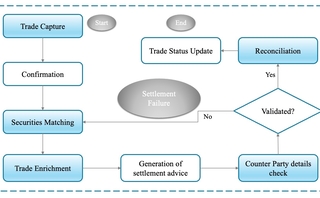Waters Wrap: Big Tech’s subtle plans for capital markets domination
Amazon, Google, IBM and Microsoft aren't just cloud providers anymore—and their tentacles are going to spread deep into trading systems going forward.

A little more than a year ago, I wrote a Waters Wrap with the headline, “The Big Tech cloud providers are coming for your toys”. The premise of the column was that the likes of Amazon, Microsoft, Google and IBM had become the most important infrastructure providers to capital markets firms, and it was only a matter of time until they took aim at other parts of the trading lifecycle.
A decade ago, banks and asset management executives balked at the idea of moving precious client data to the public cloud. Today, seemingly, each week brings a new announcement from a major investment firm, exchange or vendor partnering with one of the Big 4 cloud infrastructure providers. Take, for example, CME Group, which was the first major exchange operator to make headlines after receiving a $1 billion investment from Google and inking a 10-year agreement to overhaul CME’s infrastructure and analytics capabilities. At the time, I wrote a column with this as the headline: “CME & Google—the first domino falls”.
Sure enough, Nasdaq quickly followed suit by partnering with Amazon to migrate its North American markets to the AWS cloud in a phased approach. The London Stock Exchange Group signed a 10-year deal with Microsoft that includes the software giant purchasing approximately a 4% equity stake in LSEG. The pairing will allow LSEG—the owner of Refinitiv and its Workspace collaboration tool—to tap into Microsoft’s suite of solutions, including Excel and Teams, to build unique products for trading. The Australian Securities Exchange and Deutsche Börse have announced partnerships with Google; and if you want to extend cloud beyond the Big 4, Cboe Global Markets recently signed an agreement with Snowflake. I’m sure there are others I’m missing, but you get the point.
This might be tinfoil hat stuff, but what happens when the Big Tech giants start buying up industry-specific data and tech providers? They’ll own the infrastructure, the analytics, AND the data and tech.
As Big Tech firms entrench themselves as the infrastructure providers of choice for a vast swath of the capital markets, regulators are taking notice, and there are likely some interesting discussions to be had should a major cloud outage knock out a market and disrupt trading. But what I’m finding to be most interesting are the more subtle ways that cloud providers are making themselves indispensable to financial services firms.
To start this conversation, though, some context—which is an important word for this column.
In through the back door
We write about this all the time, but the so-called era of “big data” was all about acquiring as much data as possible to better manage risk and find new sources of alpha amid shrinking margins, the need to build more diverse portfolios, and adhere to ever-increasing regulatory demands. Cloud providers were more than willing to offer their (relatively) cheap cloud storage offerings to help firms collate and store that information. But then the other shoe dropped: “Ah, shit! There’s almost too much data, and the signals we’re getting are useless!”
Having the data is just the first step—being able to provide context around that information has become the true differentiator. Or, let me word it better: Firms need more advanced analytics platforms to provide context around this tonnage of data.
Once more, cloud providers were willing to “help.” While this was happening, financial firms like Goldman Sachs have become more comfortable with the idea of not just using open-source tools, but contributing back to the open-source community with their own inventions and resources. This change in mindset has proven useful to the Big Tech companies, whose open-source AI solutions have helped to open new avenues for machine-learning exploration to banks and asset managers that couldn’t afford “Google engineer” salaries.
While the hype around AI has existed for many years, and banks have long over-talked their capabilities in machine learning, there does appear to be a sea change underway with the commercial advent of large language models. The most attention-grabbing LLM is ChatGPT, which was developed by OpenAI, the startup into which Microsoft has invested more than $13 billion since 2019. Google soon followed suit with the release of Bard, its own LLM chatbot. And IBM was next through the door with the release of Watsonx, its AI-powered data analytics platform.
Most specific to the capital markets, though, was a contribution by Bloomberg, which announced the launch of BloombergGPT, an LLM that was built using public data and data proprietary to Bloomberg. While not a chatbot, the plan is for the AI model to supercharge its ubiquitous Terminal. And with that, the floodgates have opened, proof of which can be seen with recent earnings calls. Some examples:
“As a technology company, we cannot afford not to try to be at the forefront of the technology. … It’s our explicit wish and our ambition that we are not becoming a laggard in this field.” – Theodor Weimer, CEO, Deutsche Börse.
“As MSCI explores new ways to turn raw data into valuable insights, we continue moving forward with our technology transformation—and generative AI and large language models are a big part of that.” – Baer Pettite, COO, MSCI.
“In the same way we’ve built a consulting practice around Red Hat’s hybrid cloud platform that is now measured in the billions of dollars, we will do the same with AI. And just like OpenShift is the technology platform at the heart of our hybrid cloud capabilities, Watsonx will be the core technology platform for our AI capabilities.” Arvind Krishna, CEO, IBM.
“Every customer I speak with is asking not only how, but how fast they can apply next-generation AI to address the biggest opportunities and challenges they face, and to do so safely and responsibly.” – Satya Nadella, CEO, Microsoft.
“The convergence of technological progress and the value of what it can accomplish today is because of the massive proliferation of data, the availability of extremely scalable computing infrastructure and the advancement of ML technologies over time.” – Swami Sivasubramanian, VP of databases, analytics, and ML, AWS, while speaking the AWS Summit in New York on July 26.
I’ve also recently had conversations with executives at Nasdaq and ICE where we discussed LLMs, as well as with companies like Symphony and FlexTrade. I anticipate that many conversations that I have over the course of the rest of this year will involve LLMs, chatbots and generative AI.
But the point of this column is this: While a tech behemoth like Bloomberg might be able to build its own LLM using corpuses derived from its internal data, and various other data providers and tech vendors can create tools tailored to their clients’ needs, the true innovators in the space will continue to be Amazon, Google, IBM and Microsoft. If it’s machine learning and natural language processing that allows firms to quickly dig through huge datasets and bring forth valuable insights, signals and warnings, and it’s those Big 4 firms who are driving innovation in these technologies, then that means the Big 4 will be the providers who underpin the analytics tools firms use to derive context from all this cloud-stored data…the same clouds owned by the Big 4.
This might be tinfoil hat stuff, but what happens when the Big Tech giants start buying up industry-specific data and tech providers? They’ll own the infrastructure, the analytics, AND the data and tech. People have often told me that Big Tech doesn’t want to deal with the regulatory barriers that are ever so prevalent in the capital markets. But in the span of a decade, these companies have taken over the infrastructure space and now the AI (i.e., analytics) space. Quantum computing is coming, too, and guess which firms are at the forefront of that technology’s development? Here’s a hint. Oh, and cutting-edge encryption? Yeah, they’re on that, too.
I have no opinion as to whether this is a good or bad thing. I do think it will take time for these rather “out there” ideas to come to fruition. But if you’re not having these discussions with your tech teams and in boardroom meetings, I fear that you may be in for as rude an awakening as the day LLM chatbots caught you off guard.
Think I’m losing it? Perhaps one too many “happy chocolates” eaten? A few too many IPAs imbibed? Let me know: anthony.malakian@infopro-digital.com.
The image accompanying this column is “The Trojans Bring the Wooden Horse into Their City” by Jean Mignon, courtesy of The Met’s open-access program.
Only users who have a paid subscription or are part of a corporate subscription are able to print or copy content.
To access these options, along with all other subscription benefits, please contact info@waterstechnology.com or view our subscription options here: http://subscriptions.waterstechnology.com/subscribe
You are currently unable to print this content. Please contact info@waterstechnology.com to find out more.
You are currently unable to copy this content. Please contact info@waterstechnology.com to find out more.
Copyright Infopro Digital Limited. All rights reserved.
You may share this content using our article tools. Printing this content is for the sole use of the Authorised User (named subscriber), as outlined in our terms and conditions - https://www.infopro-insight.com/terms-conditions/insight-subscriptions/
If you would like to purchase additional rights please email info@waterstechnology.com
Copyright Infopro Digital Limited. All rights reserved.
You may share this content using our article tools. Copying this content is for the sole use of the Authorised User (named subscriber), as outlined in our terms and conditions - https://www.infopro-insight.com/terms-conditions/insight-subscriptions/
If you would like to purchase additional rights please email info@waterstechnology.com
More on Emerging Technologies
Quants look to language models to predict market impact
Oxford-Man Institute says LLM-type engine that ‘reads’ order-book messages could help improve execution
The IMD Wrap: Talkin’ ’bout my generation
As a Gen-Xer, Max tells GenAI to get off his lawn—after it's mowed it, watered it and trimmed the shrubs so he can sit back and enjoy it.
This Week: Delta Capita/SSimple, BNY Mellon, DTCC, Broadridge, and more
A summary of the latest financial technology news.
Waters Wavelength Podcast: The issue with corporate actions
Yogita Mehta from SIX joins to discuss the biggest challenges firms face when dealing with corporate actions.
JP Morgan pulls plug on deep learning model for FX algos
The bank has turned to less complex models that are easier to explain to clients.
LSEG-Microsoft products on track for 2024 release
The exchange’s to-do list includes embedding its data, analytics, and workflows in the Microsoft Teams and productivity suite.
Data catalog competition heats up as spending cools
Data catalogs represent a big step toward a shopping experience in the style of Amazon.com or iTunes for market data management and procurement. Here, we take a look at the key players in this space, old and new.
Harnessing generative AI to address security settlement challenges
A new paper from IBM researchers explores settlement challenges and looks at how generative AI can, among other things, identify the underlying cause of an issue and rectify the errors.








